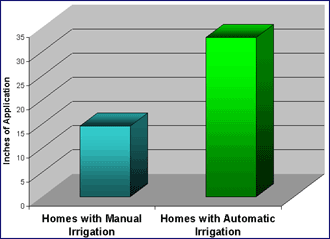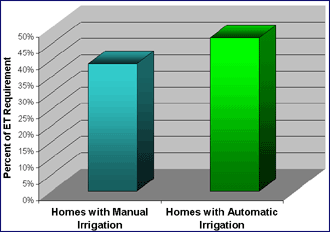Almost every homeowner in the U.S. spends some amount of time and money delivering water to outdoor plants – especially grass. There are two basic ways to accomplish this task:
- Manual irrigation with hoses, nozzles, and sprinklers
- Clock driven in-ground automatic irrigation
There are hybrids of these two such as an in-ground sprinkler system that is manual operated or an above ground hose system that is clock driven, but these systems are less common.
Most new homes come equipped with some form of clock driven automatic irrigation because this is a popular amenity that many people have come to expect.
Manual irrigation is time and labor intensive and requires regular attention and vigilance. An automatic irrigation system can be simply programmed turned on and left to run. We don’t recommend this “hands off” approach as it almost always results in over-watering and water waste, but there is no denying the convenience of an automatic irrigation system.
Convenience aside, there are a number of issues that should be considered when choosing an irrigation method:
- Budget – can I afford the system, maintenance costs, and the increased cost of water associated with an automatic system?
- Landscape – does my landscape justify an automatic system? Can I effectively irrigate my landscape manually?
- Physical condition – am I physically capable of manually irrigating my landscape?
There are a variety of manual sprinklers available that make the job easier. If you have a fairly large yard to manually irrigate, consider purchasing a “tractor” style sprinkler. This heavy duty sprinkler uses the hose as a rail and crawls along as it waters travelling across the yard.
An underground irrigation system is the most expensive, but also the most convenient method, and may be considered for large lawns.
Water Use Rates
Homes with automatic sprinkler systems use more than twice as much water on average than homes that manually irrigate with a hose and sprinkler. In another study, homes with in-ground sprinkler systems with timers used an average of 43% more water than homes with in-ground sprinkler systems without timers.
This result takes into consideration difference in landscape size, but doesn’t consider landscape quality or landscaping materials (turf, Xeriscape, etc.). These results are shown in Figure 1.

Figure 1
Although homes equipped with automatic sprinkler systems use substantially more water than their “hose dragging” counterparts, research shows that on average these homes do not use more water than the local climate conditions indicated was required for optimum growth of turf grass.
Evapotranspiration (or ET) is a measure of the amount of water required for optimum plant growth that is based on a number of factors including temperature and precipitation.
When the water use of manual and automatic irrigators is compared against the local ET rate is can be seen that on average manual irrigators applied 39% of the theoretical ET requirement and automatic irrigators applied 47% of the ET requirement.
These results are shown in Figure 2. This means that although homes with automatic sprinklers use more water, they are still irrigating quite efficiently on average.

Figure 2
- Hiring a Landscape Professional - January 19, 2017
- Water-Wise Plant Materials - January 13, 2017
- Water-Wise Plants Timing and Seasonality - January 13, 2017
